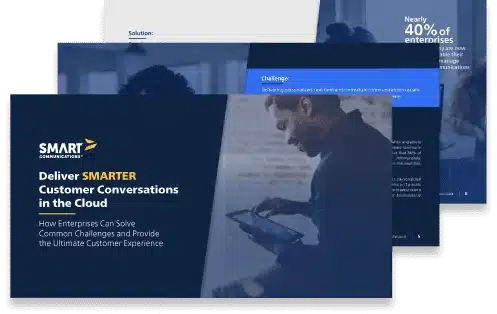How to Improve Patient Experience with Forms
By John Zimmerer, VP of Healthcare Marketing at Smart Communications
Patients are sick…of tedious, cumbersome forms. They’re everywhere in healthcare and they provide bad patient experiences. Most repeatedly ask for the same information, the majority are long or otherwise complex, and many need to be printed out and signed by hand. Signing sounds simple, until you consider those patients that have a hand injury, are arthritic, or are otherwise unable to put pen to paper.
I’ll say it: Your forms are evidence of a complete lack of empathy for patients.
First Things First: Acknowledge the Burden You Place on Patients During Intake
Technically, the process of finding then scheduling care provides the first impression. In most cases, that happens over the phone or online, so it feels separate. Intake (or admissions) is usually done onsite, in person, and on the day of the appointment and it’s full of paper forms, including:
- A patient demographic information sheet
- An informed consent form
- Authorizations and assignments (e.g., patient responsibility for payment)
- Appointment of a personal representative form
- Coordination of benefit forms
- HIPAA authorization to release information
That’s already a lot of forms, and the list doesn’t include patient-, provider-, or procedure-specific forms like a new patient health history or screening tools like abuse or social determinants of health.
Often, these forms are individual documents that are manually selected and collated by staff, which means it’s easy to miss one. And because they’re created as individual forms, they each require a patient signature. My hand cramps just thinking about the intake process!
Next Steps: Understand Where the Issues Arise with Your Form Processes
Many of the same forms need to be completed for each patient visit. For example, Medicare-eligible patients are supposed to complete a Medicare Secondary Payer questionnaire every time services are rendered. This often means the patient is handed a fresh set of blank forms that must be filled out from scratch. This compounds the frustration and anxiety patients feel and reinforces a bad patient experience.
Studies from the Centers for Medicare and Medicaid Services (CMS), The Department of Health and Human Services (HHS), and the Kaiser Family Foundation (KFF), as well as our own research, show that patients expect known information to be pre-populated on forms. Patients prefer to be able to review and revise information rather than reenter it. This is rarely the case with healthcare forms.
There Is a Solution: Digitally Transform Your Patient Experience with Forms
Thankfully, there is a better way.
Our SmartIQ™ software makes it easy to transform your patient forms into guided digital experiences. These experiences can be embedded in patient portals and apps and branded to match. SmartIQ can integrate with your EHR, RCM and other back-office systems to pull in known patient data so that patients and staff don’t need to rekey information. Information can be entered once and automatically applied to multiple forms. Patients can attach required documents like insurance cards, medication lists, and advance directives with the click of a button from the comfort of their home (where they likely keep this information).
Forms can be started at home on one device, including mobile phones and tablets, and completed in your office on another. And SmartIQ integrates with popular digital signature solutions so that multiple forms can be signed at once. Then, the completed forms can be sent either as data or documents to your applications or document repository.



